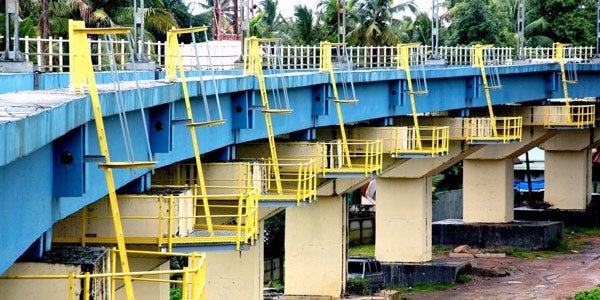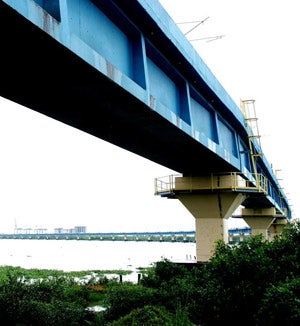
RVNL’s Vallarpadam Railway Bridge
Ercon Composites, a leading pultruder in India which has made quality pultrusions since 1993, recently completed the largest project of its kind in the world. It supplied 117 structural platforms – completely prefabricated in-house – for RVNL’s Vallarpadam Railway Bridge.
Several designs and sizes of platforms were installed with its supervision in a very difficult site on a sea bridge at Kochi-Kerala. The platforms consisted of GRP I-sections, channels, angles, cage ladders, gratings and hand rails.
Almost 90mt of GRP pultruded structures were used in the project, which were pultruded by Ercon Composites. The structures were fabricated to the minutest detail, along with SS bolts and nuts, at Ercon’s works. The complete design, validation and prototyping was all done in-house at Ercon.
Ercon Composites completed the fast-tracked project in just seven months. Such a large project is a big achievement for any company.
The RVNL bridge has 117 piers of concrete. The railway wanted inspection platforms on each pier for the inspection of bearings. Most of the piers are under the sea. Constructing RCC inspection platforms was next to impossible and uneconomical as it required shuttering and concreting / casting on each pier in the centre of the sea.
Using metal was not advisable due to the project being offshore; therefore, with corrosive salty winds and water sprays, metal will not last and installation would be difficult due to its weight.
Ercon Composites was approached to advise feasibility of making the complete structural platform in GRP. It took up the challenge and prepared a feasibility report, which was examined by the main contractor AFCONS who had constructed the bridge and they accepted its concept.
But it was a challenge to convince the railway to accept the same, since no similar work had been done in the past anywhere in the world. A detailed calculation was done, and a prototype developed and tested at Ercon’s works, and finally RVNL accepted the proposal.

Fast-track
The job was awarded to Ercon Composites in November 2010 and the project was to be completed before the rainy season started in June 2011. It was professionally planned and executed and completed well within the time schedule.
Speciality
The complete platform was built from pultruded composites, except for the base plates, anchors and assembly bolt and nuts which were made from SS316.
Design
Specially designed cantilever beams were used instead of braced brackets of GRP, since headroom space was a constraint -specified by RVNL.
Zero waste
All the components were pre-designed and produced by pultrusion in specific lengths to avoid any waste. Gratings as long as 13m – 14m were pre-fabricated and then cut at such an angle to create corner joints and walkway panels with zero wastage.
Huge quantum
Almost 90t of GRP pultrusions were used in the project.
Ease of installation
The installation work required transferring the material in the middle of the sea on each pier by either boats or through a four mile long railway track. Hangars were suspended from the top of the bridge to the pier base from the top, for workers to stand and install. Strong winds and rain kept on creating difficulties but being lightweight, GRP could be installed easily.
Cost saving
The installation cost was much lower due to GRP being lightweight and easy to fabricate and modify at the site. As a result, the overall cost turned out to be less than if galvanised or SS material would have been used.
Capability
This is a project which shows the capability of Indian GRP manufacturers. It also proves GRP material is now making fast progress in the infrastructure sector in India. This new generation material is now being accepted; it will take time but soon the use of GRP will be widespread.

